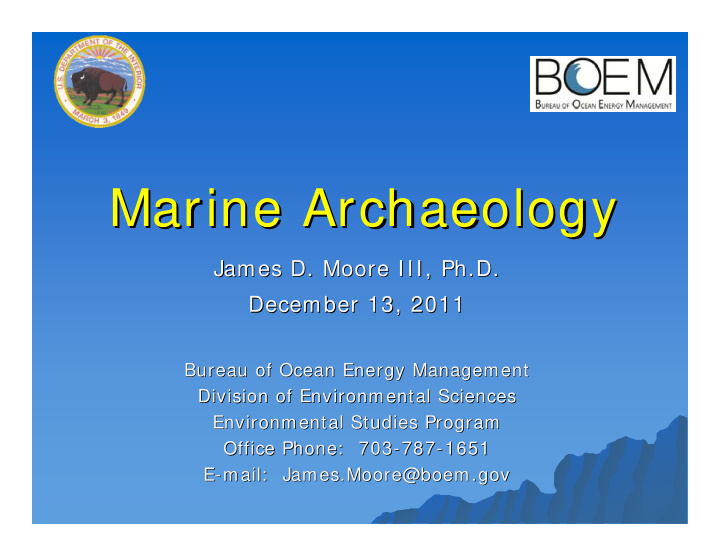



Marine Archaeology Marine Archaeology James D. Moore III, Ph.D. James D. Moore III, Ph.D. December 13, 2011 December 13, 2011 Bureau of Ocean Energy Management Bureau of Ocean Energy Management Division of Environmental Sciences Division of Environmental Sciences Environmental Studies Program Environmental Studies Program Office Phone: 703- Office Phone: 703 - 787 787- - 1651 1651 E- - mail: mail: James.Moore@boem.gov James.Moore@boem.gov E
Importance of Archaeology Importance of Archaeology The surveying of artifacts allows The surveying of artifacts allows researchers to determine past cultural researchers to determine past cultural behavior in the absence of historical behavior in the absence of historical information information Artifacts are non Artifacts are non- - renewable resources that renewable resources that are physical representations of our past are physical representations of our past Material remains are indicative of specific Material remains are indicative of specific cultural, technological, and economic cultural, technological, and economic changes through history changes through history
BOEM’ ’s s Responsibility for Protecting Responsibility for Protecting BOEM Submerged Cultural Resources Submerged Cultural Resources National Historic Preservation Act National Historic Preservation Act (NHPA), Section 106 (NHPA), Section 106 Executive Order 11593 Executive Order 11593 Notice to Lessees (NTL) stipulating Notice to Lessees (NTL) stipulating areas of avoidance due to cultural areas of avoidance due to cultural sensitivity sensitivity Lessees Lessees required to survey and required to survey and report findings report findings
Interdisciplinary Collaboration for Interdisciplinary Collaboration for Understanding Underwater Understanding Underwater Site- - Formation Processes Formation Processes Site Technological advances are allowing Technological advances are allowing access to sites in deeper waters access to sites in deeper waters Time Time- - dependent mechanisms dependent mechanisms transfer artifacts into spatial contexts transfer artifacts into spatial contexts that must be interpreted that must be interpreted Marine environments affect the perception Marine environments affect the perception of archaeological contexts of archaeological contexts Materials degrade at variable rates Materials degrade at variable rates
The Gulf of Mexico The Gulf of Mexico Collaborative effort with BOEM, NOPP, NOAA OE, state universities, private companies, and the PAST Foundation (non-profit) Recipient of DOI’s Cooperative Conservation Award in 2006 Recipient of the 2006 NOPP Award
Deep Wrecks Project Survey Area: The Depicted Region Contains ~ 500 Oil and Gas Rigs
M/ V Gulfpenn Gulfpenn ’s Bow Main Deck
U- 166
SS Robert E. Lee Side-Scan Sonar Image Aft Deck Gun
The Gulf of Mexico (cont.) The Gulf of Mexico (cont.) Mardi Gras Shipwreck Site (Located in the Vicinity of the U- 166 and Robert E. Lee ) Bow Stern
The Gulf of Mexico (cont.) The Gulf of Mexico (cont.) Surveying for Prospective Prehistoric Native American Sites Sub-bottom profiler Sub-bottom profiler data (example) Sub-bottom profiler data (example)
Atlantic Atlantic Recipient of the Secretary of Interior’s Partners in Conservation Award Winner in 2009 BOEM’s Chris Horrell diving on the Kassandra Louloudis Mosaic of the U- 85, sunk April 13, 1942
Pacific Inventory Study Pacific Inventory Study Develop a database of known, reported and prospective submerged sites Requires an effective remote sensing survey strategy Develop a model for prehistoric site locations Adapt future energy development plans to avoid sensitive areas
Assessing Visual Impacts from Assessing Visual Impacts from Coastal Historic Properties Coastal Historic Properties Shoreline view of a wind facility Shoreline view of a wind facility (closest turbine is 4.6 miles) (closest turbine is 7.1 miles)
Management for Potentially Polluting Management for Potentially Polluting Wrecks Wrecks SS Jacob Luckenbach USS Mississinnewa
Future Project: Identification of Future Project: Identification of Submerged Prehistoric Native American Submerged Prehistoric Native American Sites off Southern New England Sites off Southern New England Incorporate local tribal knowledge and oral traditions to create a Paleo-cultural landscape model Train tribal representatives in offshore geophysical and archaeological survey techniques Refine protocols for the identification of potential cultural sites
Archaeological Resource Sensitivity Map for Southern New England ME NH MA CT RI
Thank You Thank You
Recommend
More recommend